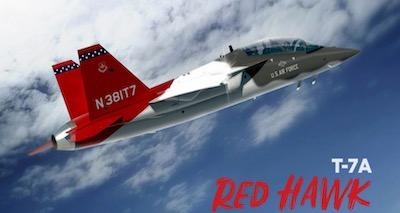Official Designation For Boeing's T-X Trainer
The Air Force’s all-new advanced trainer aircraft, the T-X, has officially been named the T-7A Red Hawk.

Acting Secretary of the Air Force Matthew Donovan made the announcement during his speech at the 2019 Air Force Association’s Air, Space and Cyber Conference in National Harbor, Sept. 16.
Donovan was joined on stage by one of the original Tuskegee Airmen, Col. Charles McGee, who flew more than 400 combat missions in World War II, Korea and Vietnam. Also seated in the audience were members of the East Coast Chapter of the Tuskegee Airmen.
After a short video highlighting the aircraft’s lineage, Donovan said, “ladies and gentlemen, I present to you the newest Red Tail!” A drape was then lifted to reveal a quarter-scale model of a T-7A Red Hawk painted in a distinct, red-tailed color scheme.
“The name Red Hawk honors the legacy of Tuskegee Airmen and pays homage to their signature red-tailed aircraft from World War II,” Donovan said. “The name is also a tribute to the Curtiss P-40 Warhawk, an American fighter aircraft that first flew in 1938 and was flown by the 99th Fighter Squadron, the U.S. Army Air Forces’ first African American fighter squadron.”
The Tuskegee Airmen subsequently painted their Republic P-47 Thunderbolts and North American P-51 Mustangs with a red-tailed paint scheme.
The T-7A Red Hawk, manufactured by Boeing, introduces capabilities that prepare pilots for fifth generation fighters, including high-G environment, information and sensor management, high angle of attack flight characteristics, night operations and transferable air-to-air and air-to-ground skills.
“The T-7A will be the staple of a new generation of aircraft,” Donovan said. “The Red Hawk offers advanced capabilities for training tomorrow’s pilots on data links, simulated radar, smart weapons, defensive management systems, as well as synthetic training capabilities.”
Along with updated technology and performance capabilities, the T-7A will be accompanied by enhanced simulators and the ability to update system software faster and more seamlessly. The plane was also designed with maintainers in mind by utilizing easy-to-reach and open access panels.
The T-7A features twin tails, slats and big leading-edge root extensions that provide deft handling at low speeds, allowing it to fly in a way that better approximates real world demands and is specifically designed to prepare pilots for fifth-generation aircraft. The aircraft’s single engine generates nearly three times more thrust than the dual engines of the T-38C Talon which it is replacing.
“The distance between the T-38 and an F-35 is night and day,” said Air Force Chief of Staff General David L. Goldfein. “But with the T-7A the distance is much, much smaller, and that’s important because it means the pilots trained on it will be that much better, that much faster at a time when we must be able to train to the speed of the threat.”
A $9.2 billion contract awarded to Boeing in September 2018 calls for 351 T-7A aircraft, 46 simulators and associated ground equipment to be delivered and installed, replacing Air Education and Training Command’s 57-year-old fleet of T-38C Talons.
The first T-7A aircraft and simulators are scheduled to arrive at Joint Base San Antonio-Randolph, Texas, in 2023. All undergraduate pilot training bases will eventually transition from the T-38C to the T-7A. Those bases include Columbus Air Force Base, Mississippi; Laughlin AFB and Sheppard AFB, Texas; and Vance AFB, Oklahoma.
(Image provided with USAF news release)
 ANN's Daily Aero-Term (07.15.25): Charted Visual Flight Procedure Approach
ANN's Daily Aero-Term (07.15.25): Charted Visual Flight Procedure Approach Aero-News: Quote of the Day (07.15.25)
Aero-News: Quote of the Day (07.15.25) ANN's Daily Aero-Linx (07.15.25)
ANN's Daily Aero-Linx (07.15.25) NTSB Final Report: Kjelsrud Gary Kitfox
NTSB Final Report: Kjelsrud Gary Kitfox NTSB Prelim: Cessna A150L
NTSB Prelim: Cessna A150L



